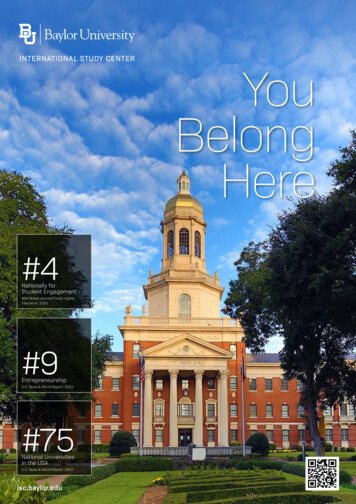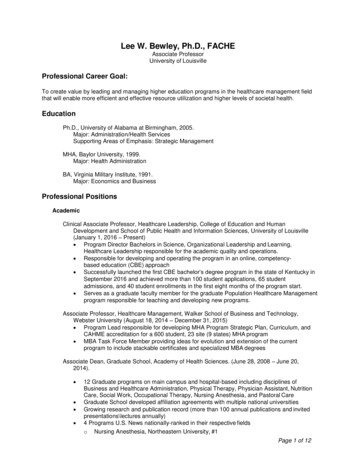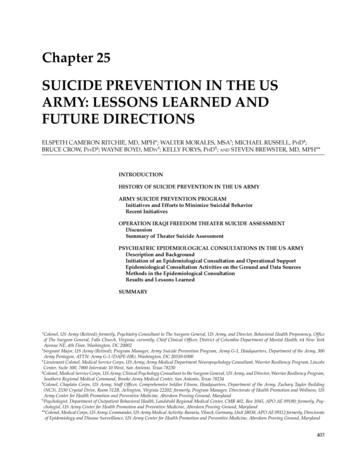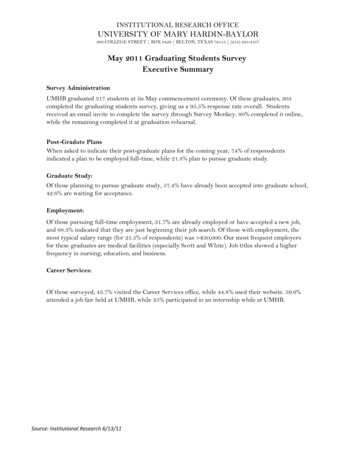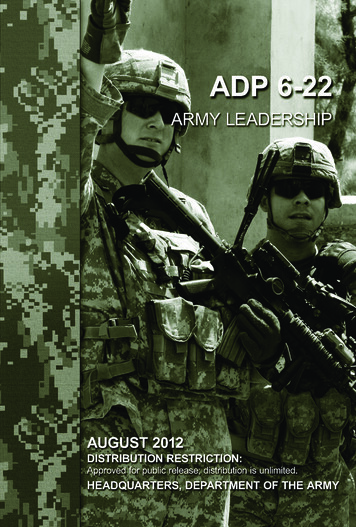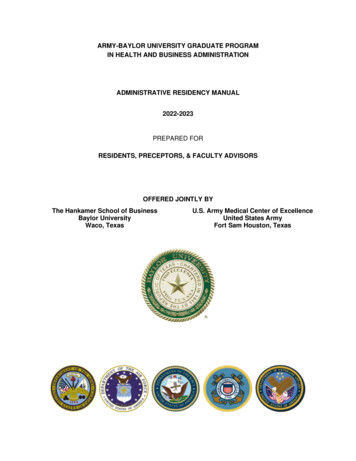
Transcription
ARMY-BAYLOR UNIVERSITY GRADUATE PROGRAMIN HEALTH AND BUSINESS ADMINISTRATIONADMINISTRATIVE RESIDENCY MANUAL2022-2023PREPARED FORRESIDENTS, PRECEPTORS, & FACULTY ADVISORSOFFERED JOINTLY BYThe Hankamer School of BusinessBaylor UniversityWaco, TexasU.S. Army Medical Center of ExcellenceUnited States ArmyFort Sam Houston, Texas
TABLE OF CONTENTSI. INTRODUCTION. 4How to Use this Residency Manual . 4The Army-Baylor MHA/MBA Program – Competency-Based Graduate Learning . 4The Army-Baylor Competency Model . 4The Electronic Baylor Experience and Assessment Review (eBEAR): . 5The Residency . 5Core Rotations. 6II. ECL & TRADITIONAL RESIDENCY PROGRAM RESPONSIBILITIES. 8Army-Baylor MHA/MBA Program Director . 8Residency Director. 8Faculty Advisors . 8Preceptors . 9Residents . 10III. TRADITIONAL RESIDENCY DATES and DELIVERABLES . 11Traditional Residency Key Dates . 11Key Deliverable Dates . 11IV. ECL RESIDENCY . 13ECL Key Deliverable Dates . 14V. ADMINISTRATIVE ITEMS . 15Canvas & Microsoft Teams . 15Dress & Appearance . 15Gifts & Travel . 15Competing Course Issues . 15Non-Disclosure Agreements . 16Requests to Curtail Residency Year . 16Graduate Management Study (GMS) . 16VI. AWARDS. 18Resident and Preceptor Awards . 18VII. RESIDENCY SITE VISITS . 19Residency Site Visits by Faculty . 19VIII. FACULTY AND STAFF CONTACT INFORMATION . 20IX. RESIDENCY PROJECTS/BEST PRACTICE SELECTION . 22ii
Residency Projects (RP) . 22Best Practice. 23X. COMPETENCY-BASED RESIDENCY REFLECTION PAPER . 24Reflective Writing . 24XI. RESIDENCY EXAMPLES and TEMPLATES . 25Residency Plan Template . 25Resident Pre-project Submission Template. 27Preceptor Post-project Assessment Template . 29Reflective Writing Template . 31My Residency Experience . 32Headers . 32References . 33Curtailment Request Example . 34Statement Certifying Completion of Residency Example . 35XII. TRADITIONAL RESIDENCY SYLLABUS. 36XIII. ECL RESIDENCY SYLLABUS . 47iii
I. INTRODUCTIONHow to Use this Residency ManualThe residency manual includes an overview of the Army-Baylor MHA/MBA program, theArmy-Baylor competency model, and responsibilities of the residency director, program director,education technician, preceptors, faculty advisors, and residents. The residency manual layoutalso includes useful forms for preceptors and residents to use during the residency year. Afterthe introduction section, faculty advisors, preceptors, residents, and ECL residents haveindependent sections that outline their responsibilities and includes necessary information for asuccessful residency year. The residency manual now includes an exclusive Executive ClinicalLeadership (ECL) residency chapter.The Army-Baylor MHA/MBA Program – Competency-Based Graduate LearningMission. The mission of Army-Baylor is to inspire, educate, train, and develop graduates formanagement, administrative, and leadership positions within the federal healthcare sector;thereby, enhancing the readiness of U.S. military forces and improving the health of our activeduty service members, family, retirees, and veterans. The Army-Baylor Program aligns with theBaylor University and U.S. Army Medical Center of Excellence missions by educating midcareerists and clinical executive leaders. The program offers three-degree tracks:Master of Health Administration (MHA)MHA/Master of Business Administration (MBA)Executive Clinical Leader (MHA or MHA/MBA)The rigorous curriculum centers on six core competencies and links to the Joint MedicalExecutive Skills Program Core Curriculum. Highly qualified professors and practitioners engagein research across interdisciplinary fields and professional services, shaping the course of studyfor exceptional leaders with robust critical-thinking, ethical decision-making, and effectivecommunication skills.Objective. The objectives of the Army-Baylor University Graduate Program in Health andBusiness Administration (referred to hereafter as the Army-Baylor Program) are based onstrategic objectives set forth by the Defense Health Agency (DHA), the Surgeons General of theArmy, Navy, and Air Force, the Department of Veteran Affairs (VA), and Baylor University.Additionally, the Program’s Master of Health Administration (MHA) objectives and curriculum(both didactic and residency phases) meet the accreditation quality standards and criteria of theCommission on the Accreditation of Healthcare Management Education (CAHME). TheProgram is also accredited by the AACSB International (AACSB) for its Master of BusinessAdministration (MBA) under the Hankamer School of Business, Baylor University.The Army-Baylor Competency ModelThe Program has developed The Army-Baylor Healthcare Administrator Competency Modelfrom the Department of Defense Joint Medical Executive Skills Program (JMESP) CoreCurriculum. This updated model lays out a learning architecture of professional competenciesrequired by healthcare administrators in the modern healthcare environment. The residencyprogram facilitates development of professional competencies and management and leadershipskills. The Army-Baylor Competency Model utilizes the three-level cognitive taxonomy of theJMESP Core Curriculum: 1) knowledge, 2) application, and 3) expert. Each residencyexperience should be designed with the intent that our graduating students have developed4
knowledge, expertise, and application within the Army-Baylor competencies, appropriate formid-career healthcare administrators and/or ECLs.The Electronic Baylor Experience and Assessment Review (eBEAR):The eBEAR, a web-based tool, is used to identify, assess, make developmental plans, andsubsequently document residents’ progression along the path to Army-Baylor competencymastery. The eBEAR allows student documentation of learning experiences and provides aframework to target specific competencies to develop and engage in appropriate learning andleadership experiences during the residency year. Residents begin building their eBEAR duringtheir didactic year, documenting progression and competency development. Residents and theirpreceptors continue to build upon the didactic eBEAR throughout the residency year. TheeBEAR guides formulation of the Residency Plan, is used for continuous assessment anddocumentation of the resident’s learning experiences and demonstrates competencydevelopment through completion of the Army-Baylor MHA or MHA/MBA.The ResidencyThe residency is the application phase of the Army-Baylor MHA or MHA/MBA competencybased curriculum, which builds on competencies learned during the didactic year. Each residentis evaluated based on successful demonstration of Army-Baylor competencies, throughcompletion and assessment of a series of experiences, residency projects, and writtencommunications. The preceptor and faculty determine and certify satisfactory completion of theresidency.5
Overall objectives of the residency are to provide residents with opportunities to: Further develop Army-Baylor competencies appropriate to management, administrative,and leadership positions within the federal healthcare sector. Develop a practical knowledge of the clinical and administrative elements of healthcareinstitutions across the Army-Baylor competencies. Identify and target the resident’s skills and competencies identified by the resident,preceptor, and/or faculty advisor which require enhancement. Strengthen a code of personal ethics, a philosophy of management, and a dedication tothe high ideals and standards of excellence in federal healthcare administration. Develop Army-Baylor competencies by completing preceptor-sponsored residencyprojects and submitting written summaries of these projects for evaluation.Residents are highly encouraged to work on as many projects as possible during the residencyyear to further develop their competencies, skills, knowledge, and abilities. While therequirement is for the resident to complete three written submissions of projects (ECL completetwo residency projects) and a best practice summary, most residents conduct several projectsbeyond this requirement.Core RotationsTo ensure a robust residency experience that builds and strengthens the resident’s ArmyBaylor competencies, the Residency Plan should include interactive experiences/rotations to thefollowing core areas. The resident should plan to spend one (1) to four (4) weeks (or 40 hours to160 hours) in each area to build and/or strengthen their Army-Baylor competencies. Residentsare highly encouraged to include additional rotations not listed here, particularly experiencesthat are unique to the residency organization. Preceptors and faculty advisors should workclosely with the resident to build the Residency Plan. The following areas are considered corerotations along with suggestions for departments and/or settings which fall under the corerotations:1. Executive or Command Suitea. CEO, CFO, COO, CIO, CNO, CMO, Accreditation, HRO, or similar2. Resource managementa. Financial, Intellectual, Billing Office, other3. Logistics/Facilitiesa. Logistics, facilities management, property management, warehouse operations,acquisitions4. IT/IMa. Helpdesk, Cybersecurity, Privacy Office, Informatics5. Patient Administration/Managed Carea. Safety, quality, satisfaction, patient experience, ombudsmen, coding, ClinicalSupport Division/Decision Support Division, other6. Inpatient settingsa. Physician, nursing, scheduling (emergency care, trauma care, medicalmanagement, nursing ops, nutrition, managed care, etc.)7. Outpatient settings6
a. Physician, nursing, scheduling (Primary care, specialty care clinics, pharmacy,lab, etc.)8. Surgical settingsa. Same day, in-patient, emergent, scheduling, templating9. Behavioral Healtha. Behavioral health, social work, inpatient, other10. Education & training11. Emergency Managementa. Readiness, crisis action team, response team, other12. Human resourcesa. Legal, labor, volunteer, union representative7
II. ECL & TRADITIONAL RESIDENCY PROGRAM RESPONSIBILITIESArmy-Baylor MHA/MBA Program DirectorThe responsibilities and duties of the Army-Baylor MHA/MBA Program Director include thefollowing: Serve as the appeal authority for all disputes and curtailment issuesCertify completion of residency requirements and all winners of residency awardsOversee all Graduate Management Studies for students who fail to meet residencyrequirementsFinal approval authority for resident’s completion of degree requirementsResidency DirectorThe responsibilities and duties of the Residency Director include the following: Schedule and facilitate any preceptor and resident teleconferences and preceptortrainingEvaluate requested curtailments and recommend approval/disapproval to the ProgramDirectorCoordinate with Faculty Advisors to ensure grading of eBear and written submissionsare finalized in a timely mannerCoordinate nominations for the Boone Powell, J. Dewey Lutes, and Dean Toland awardsbased on resident performanceEstablish budget, criteria, and schedule for residency site visitsReview complaints and disputes pertaining to the administrative residency, attempting tosolve matters at the lowest level possible; provide recommendations and guidance to theresident, preceptor, and/or Program Director on further action as neededConsolidate ‘Best Practice’ recommendations for consideration by Army-Baylorpreceptors to determine a winner of the COL Richard Harder awardReview, update, and distribute the Residency Manual to residents, faculty advisors, andcurrent preceptors on an annual basisDevelop, review, update, and distribute a Residency Course Syllabus to residents,faculty advisors, and current preceptors.Serve as the official administrative point of contact for the resident and preceptor duringthe residency phase for all matters pertaining to official documentation deadlines,graduation coordination, etc., and serves as the final recipient of all officialdocumentation after receipt and approval by the preceptor and faculty advisors (eBEAR,written submissions, etc.)Facilitate discussion boards with residents to foster competency development, ensureprogress is on target, and promote esprit de corps in the cohortRecord completion of documentation on official Program recordsFaculty AdvisorsThe responsibilities and duties of the faculty advisor include the following: Provide feedback and grade written submissions in a timely manner (see KeyDeliverable Dates below)Serve as the primary contact for residency issues for the resident and preceptor8
Review and approve administrative residency plansAssist the resident and preceptor with specific aspects of residency projects (e.g.,methodology, theoretical applications, research design, etc.); offer guidance throughoutthe planning, completion, and writing of project summariesReview pre-project form for appropriateness of data and methodology and provide timelyfeedback to the preceptor and residentFacilitate communication with the resident and the preceptor to review the preceptorapproved, updated eBEARFacilitate communication with residents to discuss various topics and guide residents inidentifying, structuring, and assessing targeted experiences during the residencyCoordinate with preceptor on all administrative aspects of residency, as neededProvide recommendations on residency curtailmentAssume preceptor duties in case of curtailments without interim preceptorsReview quarterly eBEAR and written submissions to maintain oversight of the residencyexperience and certify sufficient academic rigor has been applied during the residencyyearPreceptorsThe responsibilities and duties of the preceptor include the following: Formally evaluate all deliverables submitted by resident to include quarterly eBEAR,conducting post-project assessments, and reviewing written submissions in a timelymanner (see Key Deliverable Dates below)Orient the resident to the institution; we recommend discussing the following topics at aminimum: Mission, vision, values, and history of the organization Structure of the organization The healthcare facility and surrounding area Community health facilities and organizations Area associations Area planning agencies Area fiscal intermediaries and third-party payers Public health activities Managed care activities Mental health activities Medical, dental, nursing, and labor societies and organizations Command/organization financial structure Committees (structures, compositions, and responsibilities)Guide the resident to find, plan, and execute projects and subsequent reportsProvide the residency infrastructure, to include office space and computer for theresident, adequate to support executive level communication and project developmentReview the incoming resident’s eBEAR from the didactic year and discuss with thefaculty advisor and resident about goals, strengths, further opportunities for competencydevelopment, etc.Take an active role in the development of the administrative residency planTake an active role in the development of appropriate residency projectsUse the eBEAR to identify opportunities to further develop specific Army-BaylorCompetencies and characteristics by identifying, structuring, and assessing targetedexperiencesPeriodically interact with faculty advisor to discuss the development of the resident9
Participate in the quarterly Preceptor teleconferences (when scheduled)Guide the resident throughout the residency to facilitate learning through projects andintegrative experiencesDetermine if the resident is demonstrating a progressive and appropriate level ofmastery of the Army-Baylor competenciesFormally evaluate all deliverables submitted by resident to include initialing quarterlyeBEAR, conducting a post-project assessment, reviewing written submissionsSupport resident attendance and participation in national or regional professionalmeetings of a professional association for healthcare administrationProvide recommendation on resident-requested curtailmentsEnsure the resident coordinates any requested residency curtailments and other majorchanges to the residency plan with the Residency Coordinator, the resident’s facultyadvisor, and the Army-Baylor Program DirectorAttend Army-Baylor MHA/MBA Program preceptor training annually or watch recordingof the annual trainingForward any concerns or disputes regarding the resident or the Army-Bayloradministrative residency program via email to the Residency Director for considerationby the Residency Committee and/or the Program Director as neededComplete the preceptor survey, final competency assessment, and statement ofresidency completion or failure at the end of the residency yearComplete mid-year and end of residency competency assessments of the assignedresident(s)ResidentsThe responsibilities and duties of the resident include the following: Complete all residency requirements and deliverables in accordance with the residencymanual, ensuring strict adherence to required submission dates and timesSubmit all deliverables on time, Failure to do shall lead to academic probation andeventual removal from the program (see Traditional Key Deliverable Dates below)Develop a rigorous residency plan in close collaboration with the assigned preceptor andfaculty advisorExecute the residency plan while allowing for inclusion of developing opportunitiesSubmit a report every other week to preceptor and faculty advisor summarizing learningexperiencesConsult with the preceptor and faculty advisor while developing residency projects;residents may solicit guidance at any time from the faculty advisors and others by usingthe Army-Baylor Residency Project Draft/Outline FormUpdate the eBEAR, ensuring that residency activities, projects, and goals align with andfurther develop Army-Baylor competenciesWork closely with the preceptor to development and complete residency projectstargeted toward Army-Baylor competency developmentAttend meetings, symposiums, trainings, and strategy sessions as directed by preceptorEnsure that the preceptor reviews and approves written submissions and eBEAR beforeposting to CanvasComplete end-of-year resident surveySubmit a recommendation for Dean Toland Preceptor of the Year Award (optional)Develop and plan itinerary for any Army-Baylor faculty site visits (if applicable)Submit curtailment request to preceptor, faculty advisor, and Residency Director forprogram director approval/denial (if applicable)10
Forward any concerns or disputes regarding the preceptor, organization, or residency inwriting to the Residency Director for consideration by the Residency Committee and/orthe Program Director as needed (e-mail is sufficient)III. TRADITIONAL RESIDENCY DATES and DELIVERABLESTraditional Residency Key Dates The Residency begins 18 July 2022 and ends 14 July 2023Preceptor Training 15 June 20221st Meeting with preceptor, faculty advisor, and resident due by 26 August 2022Key Deliverable DatesDUE DATE DELIVERABLEDraft Residency01 August 2022 PlanPost-didactic01 August 2022 eBEAR26 August 202231 August 202230 September2022Initial ResidencyPlanDiscussionBoard – InitialThought &Impressions ofSiteDiscussionBoard – BestPractices fromthe FieldPREPARED BYTHRUFINAL APPROVALResidentResidentFaculty AdvisorResidentPreceptorFaculty AdvisorFaculty AdvisorPreceptorFaculty AdvisorFaculty AdvisorResidentResident31 October 2022 Pre-project #130 November2022 Pre-project #2Resident09 January 2023 Mid-termeBEAR/Updateto ResidencyPlan20 & 27 January Best Practice2023 PresentationsResident31 January 2023 Pre-project #328 February2023 Post-project #1Resident31 March 2023 Post-project #2Resident30 April 2023 Post-project #3ResidentResidentResidentResidentFaculty AdvisorPreceptorFaculty AdvisorFaculty ptorFaculty AdvisorResidencyCoordinatorPreceptorFaculty (Cohort)Residents(Cohort)FacultyFacultyFaculty AdvisorFacultyFacultyFacultyFacultyFaculty11
Project12/19 May 2023 PresentationsResidency30 June 2023 Reflection PaperResidency Site30 June 2023 Profile Update30 June 2023 Final eBEARFinal Residency30 June 2023 PlanPreceptor’sStatement of30 June 2023 Completion30 June 2023 Peregrine ExamLearningEvery other Summaryweek ReportsResidentPreceptorFaculty AdvisorFacultyResidentFaculty AdvisorFacultyResidentFacultyResidentFaculty AdvisorPreceptorFaculty AdvisorPreceptorFaculty AdvisorPreceptorFaculty AdvisorFaculty AdvisorProgram DirectorPreceptorResidentResidentPreceptorFaculty AdvisorResidentFaculty AdvisorFaculty AdvisorFaculty AdvisorFaculty Advisor12
IV. ECL RESIDENCYThe Army-Baylor Program also offers the ECL Track: a condensed, one-year Programoption that allows select students to complete degree requirements for the MHA or dualMHA/MBA in one year, rather than two. This degree pathway is offered to healthcare providerswith advanced clinical degrees and at least 12 years of experience in a healthcare field.To complete all degree requirements within one calendar year, students must complete theresidency portion of the Program (nine credit hours) concurrently with their didactic studies.Students accomplish this through assignment to and working with preceptors at medicalfacilities/systems in the local San Antonio area. After initial orientation to the ECL residencyprocess in the 2nd academic semester, students travel to and engage with their residencysite(s) throughout the 3rd and 4th academic semesters, completing all residency requirementsin the 5th semester. Any reference to “ECL” guidance is specific to the ECL Resident only anddoes not pertain to the two-year traditional Residency application phase. Refer to the 2020-2021ECL Residency Overview chart for deliverables and key dates.While the ECL residency is compressed and time-limited, the resident should plan tocomplete as many of the MHA-core competency rotations to administrative and clinical areasthroughout the facility/system as feasible within the first portion of the residency. These rotationsare considered “non-negotiable” as they build on the theories, concepts, and practicespresented during the didactic year. Residents are highly encouraged to include rotations toareas that are unique to the residency site organizations. The resident should build in anyknown time breaks that may be required during the year. The resident will submit the residencyplan, upon preceptor approval, to the faculty advisor on Canvas. Residents will submit anysubsequent updates to the approved residency plan to the faculty advisor on Canvas on aquarterly basis. Refer to the overview of the ECL Residency, deliverables, and key dates.During the residency experience, ECL residents will complete three (3) reflection papers,one (1) best practice paper, and at least two (2) short-term healthcare administration projects,termed Residency Projects (RP), that demonstrate practical application of healthcare leadershipskills, strengthen the residents’ Army-Baylor competencies through work in a variety of realworld healthcare situations, and further the mission of the residency organization.The RP written summary is an executive summary, consisting of 4-8 double spaced pagesthat communicates the salient points and results of the RP. The executive summaries mustinclude sufficient information, data, or other convincing evidence (such as analysis ofalternatives, risk analysis, economic justifications, process improvement, etc.) to demonstrate tothe preceptor and Army-Baylor Faculty that the resident has strengthened their targeted ArmyBaylor Competencies. Residents must complete their RPs and submit the Summaries no laterthan the suspense date given. Failure to do shall lead to academic probation and eventualremoval from the program (see ECL Key Deliverable Dates below).13
ECL Key Deliverable DatesDUE DATE DELIVERABLEPREPAREDBYTHRUFINAL APPROVALResidentFaculty AdvisorFaculty Advisor2 Dec 2022Draft Residency PlanResidency RotationsStart5 Dec 202215 Jan 2023 Residency Project #1(Pre)Observation/Reflectio1 Mar 2023 n Paper 1&2Draft SummaryProject #1, RotationLog (Update)Residency Project #28 Apr 2023 (Pre)/Best Practice(Pre)Reflection or12 May 2023 Observation paper#3, Project #1 (Final)Final Project #2/FinalBest Practice16 Jun 2023ECL Graduate27 Jun 2023 Residency PortfolioDefenseGraduate ResidencyPortfolio Graded30 June 2023Statement CertifyingCompletion ofResidency30 June rPreceptorFaculty AdvisorPreceptorFaculty AdvisorFacultyFaculty AdvisorPreceptorFaculty AdvisorFaculty ort)FacultyFacultyN/A
The objectives of the Army-Baylor University Graduate Program in Health and Business Administration (referred to hereafter as the Army-Baylor Program) are based on strategic objectives set forth by the Defense Health Agency (DHA), the Surgeons General of the Army, Navy, and Air Force, the Department of Veteran Affairs (VA), and Baylor University.
